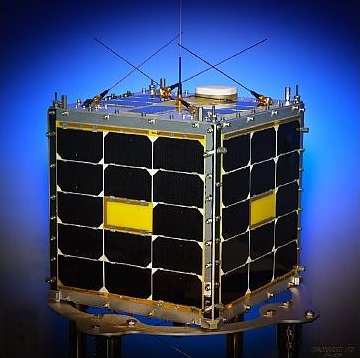AprizeSat

AprizeSat is a constellation of Low Earth Orbit satellites that provides global communication services for data transmission and fixed and mobile asset tracking and monitoring including machine to machine communications. The satellites are cubical in shape with a side length of 25 centimeters using the typical microsatellite design consisting of different trays connected by a cable harness.
The side panels are sheet metal and host the body-mounted solar panels – the four side panels generate 15 Watts of power while the top and bottom panels generate 7.7W each. The satellites uses Ultra Triple Junction Gallium-Arsenide cells with high efficiency feeding Nickel-Cadmium batteries. Peak Power Point Tracking is employed and the satellite uses regulated 3.3V, 5.5V and 12V supplies in addition to an unregulated 8V bus. The satellites use permanent magnets to keep aligned to the magnetic field of the Earth and a series of alternating strips of reflective and non-reflective tape induce a roll of about 0.25rpm to distribute sunlight on the exterior of the satellite. The spin rate is limited by magnetic hysteresis rods.
The 12-Kilogram satellites carry ten radio receivers, two power-agile transmitters and 12MB of solid sate data storage. The radios operate in the VHF/UHF frequency band to collect data from more than 100,000 user terminals each day with data rates of 1.2 to 38.8kbit/s. An S-Band terminal supports data rates of several Mbit/s for up and downlink for users with large payload data requirements.
These are the 10th and 11th satellites to be launched since 2002. The expected satellite lifetime is 10 to 12 years and the planned constellation will consist of a total of 64 satellites. AprizeSat-10 carries an Automatic Identification System Terminal. The Automatic Identification System is used by sea vessels that send and receive VHF messages containing identification, position, course and speed information to allow the monitoring of vessel movements and collision avoidance as well as alerting in the event of sudden speed changes. These signals can be transmitted from ship-to-ship and ship-to-shore to allow the monitoring of a local area, but deploying space-based AIS terminals allows a broad coverage and data relay to ground stations for monitoring of large sea areas.
